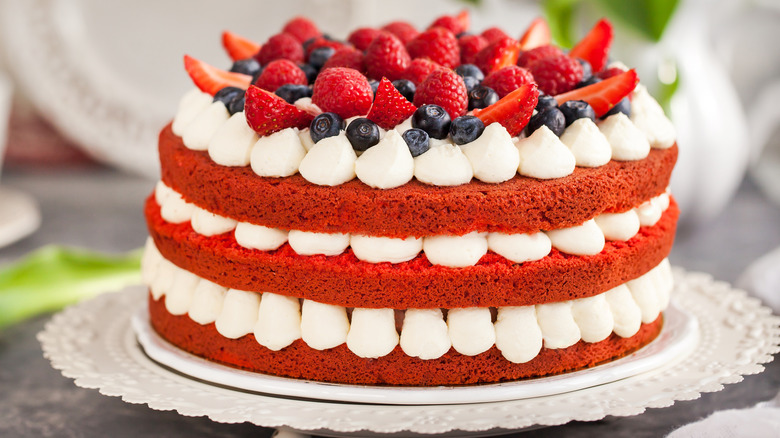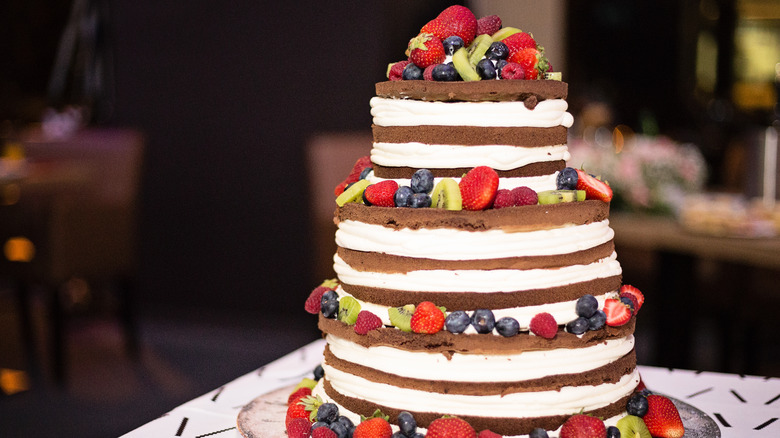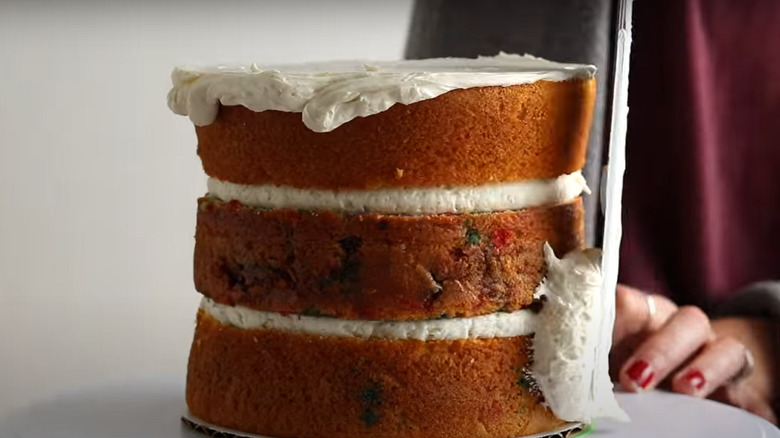What Exactly Defines A 'Naked Cake'?
"Naked cakes" have risen in popularity in the past few years, and they're here to stay. Anyone who can't stand the taste of frosting knows the beauty of a naked cake — there's usually not much icing to speak of.
Naked cakes are minimalistic — named for the sheer amount of visible cake they show. Of course, traditional cakes are covered in frosting, to the point where any spot that's missing icing is viewed as a huge bakers' gaffe. But on a naked cake, missing icing is no mistake — it's the entire goal.
Still, though, a lingering question remains: How much frosting can you get away with putting on a naked cake until it crosses the line into frosted cake territory? And can naked cakes have any frosting at all? Thankfully, there's a clear definition of what constitutes a "naked cake," but it might not be exactly what you think it is.
The definition of a naked cake
Although those "naked" wedding cakes on Instagram may seem to all look alike, there are variations on how "naked" the cake can be.
A "naked cake" usually has some frosting, though it's mostly found between the layers of cake to hold them together and add flavor and texture. It rarely has fondant or a completely iced top, and on all "naked cakes," bakers leave the sides of the cake bare or barely frosted. This makes it easy to tell which flavor it is and how appetizing the cake itself looks, which is pretty amazing. (There's nothing worse than a beautifully frosted cake with a dry, crumbly base.)
However, "naked cakes" can have a little bit of frosting on top or an extremely thin frosting coat on the sides. Frosting lovers will be pleased that they can still get some frosting, but, of course, frosting isn't the main focus of a "naked cake." Instead, you'll get to see a baker's masterpiece in its purest form — a beautiful cake with the smallest bit of equally pretty frosting spread throughout.
How to frost a naked cake
If there's barely any frosting on a naked cake, is there a certain technique for icing one well? There are hacks for decorating naked cakes, and while keeping the sides of your cake mess-free might seem daunting, it's easier than it may seem at first.
Once the bottom layer of your cake is placed on parchment paper, it's time to begin frosting. Frost the top of the bottom layer, but stop at the edges and don't go down the sides. Make sure that the frosting is evenly spread throughout the cake layer. If your cake has more than two layers, frost the tops of the remaining layers. Once you get to the top layer, you can spread frosting evenly over it as well for an immediate contrast with the texture of the cake. Then, spread as thin of a layer of frosting as possible over the rest of the cake, scraping the sides with an offset spatula to take off any excess frosting and ensure an even spread. You'll have the slightest bit of frosting holding the layers together, but you'll still get a great view of the cake itself.
Baking a "naked cake" is worth a try if you're not big on frosting. And the more you practice frosting one, the better your "naked cakes" will look with time.


